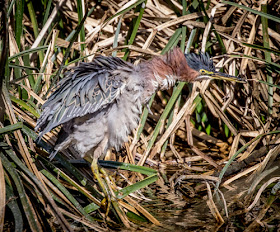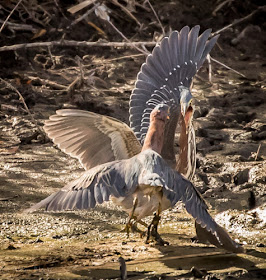Tuesday, March 20, 2018
Green Heron & Frog
A Green Heron snatches a tadpole bullfrog from a Sweetwater Wetlands retention pond.
It's curtains for a tadpole... brunch for a heron.
A few sharp shakes put and end to the tadpole's squirming, then to be swallowed whole.
Green Herons prefer hunting near the protection of dense vegetation. It's there they find their favorites of fish, amphibians, snails and even an occasional rodent.
Downing this slippery, slimy soon-to-have-been frog triggers a need to readjust.
A whole body shudder arranges his new meal and seemingly anything else misadjusted.
A short test flight to a nearby branch settles his stomach even further.
Yet more importantly, his landing nearby assures me I wasn't bothering him by being too close.
Allan
Credit: Cornell Lab of Ornithology, All About Birds
Friday, March 16, 2018
Northern Flicker (red-shafted, Western)
The Northern Flicker's true colors mainly shine in flight.
This large woodpecker with its distinctive plumage is seen all over the United States.
In the East, the yellow-shafted variation is common. In the West, the red-shafted dominate as pictured here.
The Western male has a red mustache, while the male in the Eastern half has a black mustache. You may find one high in a tree, but more likely on the ground searching for ants, a favorite food.
They'll see you approaching first and flush. Then the red or yellow flight feather coloring will be visible.
You won't miss the white rump flying away either... shared by both sexes.
There is a third species of this beautiful woodpecker called the Gilded Flicker, but they're only seen in Southern Arizona, California, and the Baja peninsula of Mexico.
The breast markings of the Northern Flicker are distinct, too. They range from multiple black dots to Valentine-shaped hearts.
(Click any picture to enlarge.)
I caught this one in a blink. Its eye was either closed or the transparent nictitating membrane that protects and lubricates the eye was shut. It's also called a 'third eyelid'.
He could have been dreaming, but he wasn't asleep.
Allan
Credits: Cornell Lab of Ornithology, All About Birds
Sibley's Guide to Birds
This large woodpecker with its distinctive plumage is seen all over the United States.
In the East, the yellow-shafted variation is common. In the West, the red-shafted dominate as pictured here.
The Western male has a red mustache, while the male in the Eastern half has a black mustache. You may find one high in a tree, but more likely on the ground searching for ants, a favorite food.
They'll see you approaching first and flush. Then the red or yellow flight feather coloring will be visible.
You won't miss the white rump flying away either... shared by both sexes.
There is a third species of this beautiful woodpecker called the Gilded Flicker, but they're only seen in Southern Arizona, California, and the Baja peninsula of Mexico.
The breast markings of the Northern Flicker are distinct, too. They range from multiple black dots to Valentine-shaped hearts.
(Click any picture to enlarge.)
I caught this one in a blink. Its eye was either closed or the transparent nictitating membrane that protects and lubricates the eye was shut. It's also called a 'third eyelid'.
He could have been dreaming, but he wasn't asleep.
Allan
Credits: Cornell Lab of Ornithology, All About Birds
Sibley's Guide to Birds
Sunday, March 11, 2018
Northern Parula
A female Northern Parula bounces between branches searching for food.
(pronounced: par-OOH-la)
The leaves in southern Arizona are just emerging, but the aphids have already discovered them.
It takes a lot of aphids to satisfy a warbler's appetite. (notice the aphid in bill) The energy expended gathering a full meal of aphids must be enormous. Parulas flit constantly.
Could aphids be that caloric?
(Click any picture to enlarge.)
It also takes dexterity and determination to find this teensy-weensy prey.
Aphids live in inaccessible places.
It's likely this Northern Parula is migrating through. Her stop here in the Sweetwater Wetlands of Tucson will be brief.
Sightings of Northern Parulas are considered rare for Arizona.
She'll probably build her nest far away... alone... in a suspended clump of moss-like vegetation. The entire eastern half of the United States and southeastern Canada is a good bet for her seasonal brood.
Oddly though, a few states will lose out. Northern Parulas typically avoid Wisconsin, Michigan and Iowa.
Clearcutting and the draining of bogs may be the reason for the Northern Parulas' decline in these States.*
You'll have a good chance of seeing a Northern Parula when you go birding. They are a bird of Low Concern* as to their species' population.
They are migrating north now. Expect them soon in your state, especially if you live east of the Mississippi River.
Allan
*Credits: Cornell Lab of Ornithology, All About Birds
Sibley's Guide to Birds
Thursday, March 8, 2018
Green Herons Battle
Dropping sharply from the air, an adult Green Heron attacks a juvenile. The juvenile showed mild concern toward the approaching adult, until it suddenly turned to panic.
The attack seemed unprovoked from my point of reference standing on the edge of this slowly draining water hole. Both birds had appeared to be tending to Green Heron business on opposite sides of the pond in mutual harmony.
A platform overlooks this area known as Sweetwater Wetlands. The pond is being drained for a controlled burn to remove excessive vegetation. Still, it seems large enough for all to coexist peacefully. A Great Egret and a Snowy Egret showed no animosity towards each other and foraged peacefully.
Unfortunately, somehow, something provoked the adult into attacking the juvenile.
It's likely the Green Heron's actions raised the pond inhabitants' anxiety level a few notches with their displays of aggression and posturing.
The adult on the left was upset at the juvenile on the right, possibly for the younger's mere presence at the pond.
That's only my observation, but Green Heron the Younger seems to be receiving a little foot action to deliver that message.
He retreats only to land across the pond at the exact spot where the adult left to initiate his attack.
Now the adult Green Heron gets to claim this lovely new section of mudflats.
I wonder how he feels about that?
Allan
Credits: Sibley's Guide to Birds
The attack seemed unprovoked from my point of reference standing on the edge of this slowly draining water hole. Both birds had appeared to be tending to Green Heron business on opposite sides of the pond in mutual harmony.
A platform overlooks this area known as Sweetwater Wetlands. The pond is being drained for a controlled burn to remove excessive vegetation. Still, it seems large enough for all to coexist peacefully. A Great Egret and a Snowy Egret showed no animosity towards each other and foraged peacefully.
Unfortunately, somehow, something provoked the adult into attacking the juvenile.
It's likely the Green Heron's actions raised the pond inhabitants' anxiety level a few notches with their displays of aggression and posturing.
The adult on the left was upset at the juvenile on the right, possibly for the younger's mere presence at the pond.
That's only my observation, but Green Heron the Younger seems to be receiving a little foot action to deliver that message.
He retreats only to land across the pond at the exact spot where the adult left to initiate his attack.
Now the adult Green Heron gets to claim this lovely new section of mudflats.
I wonder how he feels about that?
Allan
Credits: Sibley's Guide to Birds
Sunday, March 4, 2018
Cooper's Hawk
Surprise is a predator's most worthy asset.
Being one with your environment helps make predation happen. Resting motionless on a monochrome backdrop, a Cooper's Hawk watches for a dining opportunity.
Soaring quietly overhead is another stealthy approach to finding a meal.
The Cooper's Hawk is mainly a bird hunter. Typical prey includes doves, pigeons and starlings, but robins, jays and even chickens are also targets.
Though mostly in the West, small mammals like bats, chipmunks, squirrels and hares round out the Cooper's Hawks' diet.
This juvenile Cooper's Hawk looks healthy and well-fed, still, he concentrates on something of interest in the Sonoran Desert behind our home in Tucson, AZ.
Rainfall is rare in the desert, yet it happens.
Coping with the indignities of a wet feather coat once in a while comes with the territory.
(Click any picture to enlarge.)
This juvenile Cooper's Hawk is a frequent visitor on our patio.
Surprisingly, as I write this a Cooper's Hawk startled the birds on our platform feeder into panic flight. I looked up quickly enough only to see a Cooper's Hawk dart through the scattering birds. I missed the capture, but watched as a cascade of dove feathers floated back to earth.
The hawk had a meal.
It was the cycle of life playing out once again on a sunny Sunday morning.
Allan
Credits: Cornell Lab of Ornithology, All About Birds
The Sibley Guide to Birds
























